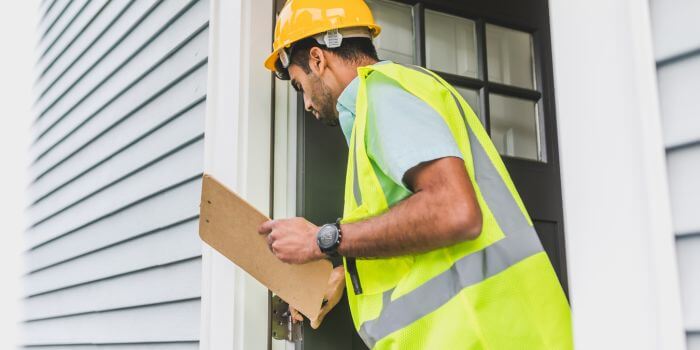Table of Contents
Building Inspections
Building inspections are crucial for managing any property successfully despite how time-consuming they can be.
By investing time and effort into assessing a building’s condition before finalizing a transaction, landlords and buyers can identify potential issues earlier rather than later and take appropriate measures to mitigate any risks.
Realizing the value of careful inspections can help you avoid problems and save money. As the expression goes, “An ounce of prevention is worth a pound of cure.”
So, let’s delve into the world of building inspections and unlock the peace of mind you deserve.
1. Start at the top and work your way down
Proceed from the highest level to the lowest. Whether you’re a private buyer or an apartment rental agency, whenever is convenient for you and your tenant is the best time to do a home inspection.
Whether you or a rental agent conducts the inspection can also make a difference, as can the length of the tenancy and the present renters’ stay.
While there are telltale signs of poor upkeep, some problems, such as smoke detector functionality or a pipe leaking inside a wall, won’t necessarily be visible at a glance.
This is why it is essential to do routine checks, even if everything appears fine on the surface. Before you decide if an inspection is needed, check for any obvious signs of deterioration and neglect.
Some of the most common issues you will notice immediately are faulty or exposed electrical wiring, structural problems like wall cracks and roof deterioration, poor drainage or plumbing, and water damage or mold issues.

2. Cover all the essentials
Some inspections are crucial to perform depending on where you are in the buying or selling process.
For example, pre-purchase inspections uncover hidden defects, structural issues, or potential safety hazards that may impact the property’s value, functionality, or legal compliance. These factors can influence a property’s value significantly,
If you own a property, routine maintenance and safety checks are necessary to ensure that your building is well-maintained, meets relevant building codes, and is always safe for occupants.
These regular assessments identify maintenance or repair needs, such as plumbing or electrical issues, roofing problems, or structural wear and tear.
To guarantee a structure is up to code, an inspection must be performed. This is particularly important during construction or renovation, as code adherence guarantees structural integrity, fire safety, and accessibility standards.
3. Know your inspection types
Another crucial factor is the type of inspection. The key is to choose the most cost-effective option for your situation.
Annual checks and evaluations at the beginning and conclusion of tenancies are the most common inspection schedules.
Periodic inspections, such as quarterly or semiannual checks, are available for those who prefer a more thorough program.
Structural inspections focus on the stability of a building’s structure, while electrical inspections ensure that a property’s electrical systems are safe and functioning properly.
Heating, ventilation, and air conditioning (HVAC) inspections analyze the performance and efficiency of airflow, whereas plumbing inspections evaluate the health of your plumbing system.
Whatever you select, it’ll go more smoothly if the tenancy agreement includes detailed instructions and a timeline.
Inspectors aren’t going to tear the home apart to check pipe integrity, but the more access they have, the more complete the final report will be.

4. Document everything
Do yourself a favor and always have an inspection checklist with you. A well-organized inventory list simplifies the task of differentiating between wear and tear and actual damage.
By maintaining a comprehensive inventory, you can effectively distinguish between expected signs of usage and more significant issues.
For instance, minor marks on walls, peeling wallpaper, or slightly loose edges on carpets typically fall under the category of fair wear and tear.
On the other hand, substantial sections of torn wallpaper, extensively stained or soiled carpets, and instances of broken doors, walls, or furniture, are considered instances of ‘damage.’
An inventory — accompanied by detailed photographs — also serves as essential evidence if you need to claim damages. Documenting the property’s condition through visual records provides solid proof of your claims for repairs or replacements.
5. Learn from the experience
Did you know there are over 20 critical points for installing a hot water pressure geyser? From the electrical connections to the relief valves, each link in the chain of a geyser can become compromised.
The trouble is you have to get into the install space to see if a geyser has been properly and safely installed, which means getting your hands dirty or paying someone else to do it.
You’ll only learn about nuances like geyser assembly through time and experience. That’s why it’s so important to bring in an expert inspection.
Research reputable, experienced inspectors, such as licensed home inspectors, structural engineers, electricians, plumbers, or HVAC technicians.
Make sure you hire the correct inspector by asking for referrals, checking reviews, and checking credentials.
Conclusion
Professional inspections provide valuable insights and peace of mind to all parties. Still, familiarizing yourself with the inspection process and the signs to look out for when an inspection is needed is always worthwhile.
The best practice is to proactively seek professional expertise to identify potential issues before they become catastrophes, ultimately safeguarding your investment and the well-being of tenants.
Also, Read
Important Repair Works You Need to Do After Purchasing a Used Home
Cost-Effective Ways to Enhance The Durability of Your Wood Floor
5 Essential Factors to Consider When Building A House
Creative Ways to Cover The Hairline Cracks in Your Wall